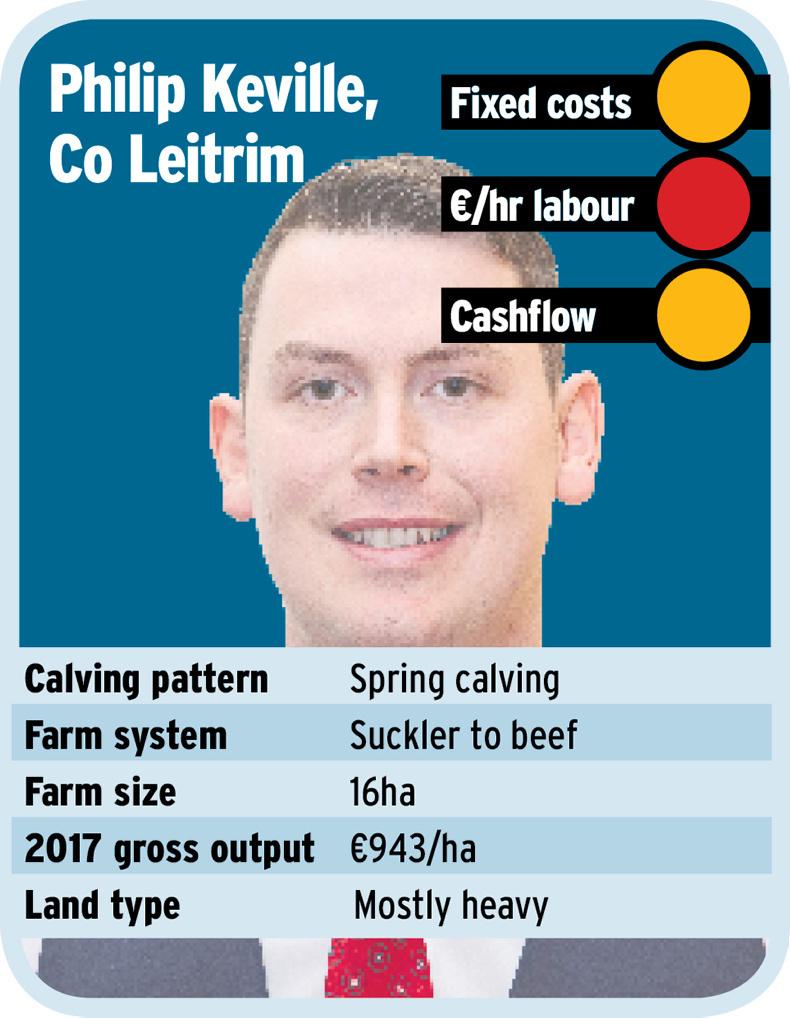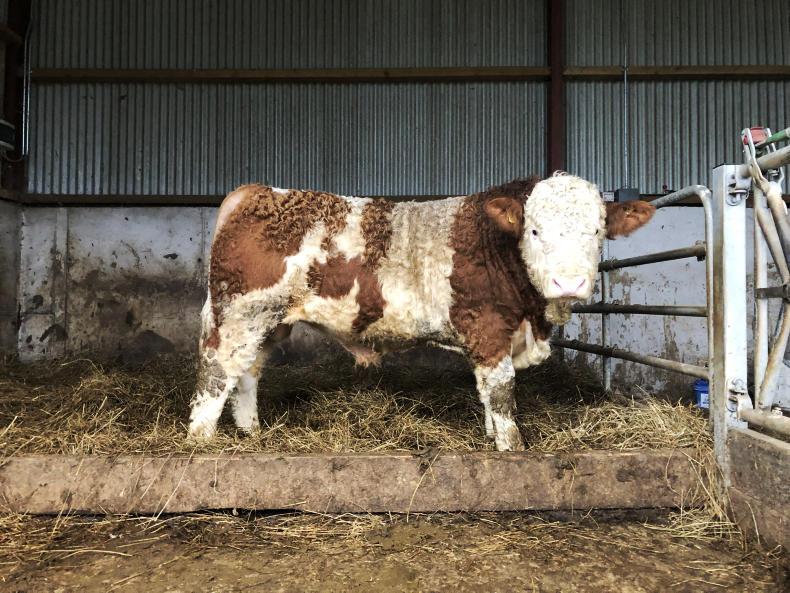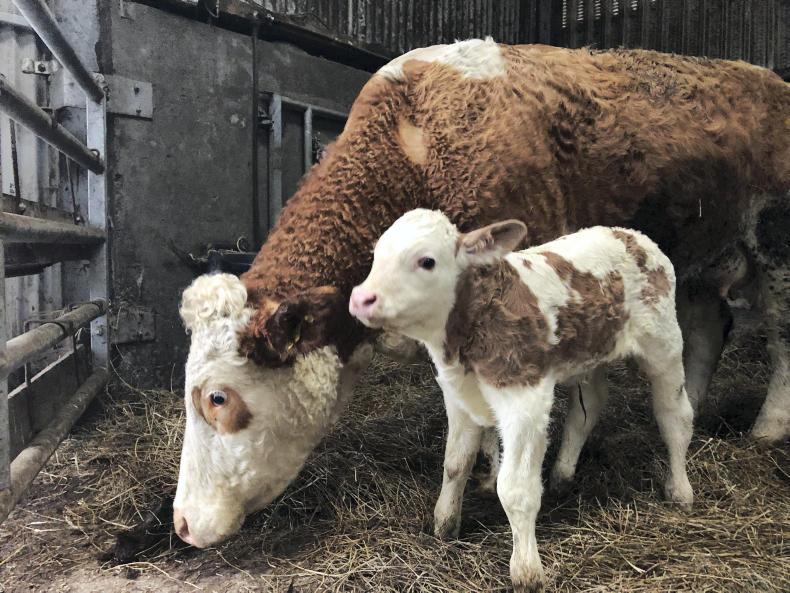Philip Keville is the Leitrim participant of the Teagasc/Irish Farmers Journal BETTER Farm beef challenge.
The land base is comprised of slightly under 16ha located just outside Aughamore village, which sits along the main N4, Dublin to Sligo road.
Land type on the farm is reasonably good throughout, although there are some heavy areas.
These wetter parts are continually being improved upon, and this summer’s drought gifted the perfect opportunity to put in a series of drains in some wet parts, which were subsequently reseeded.
On 16ha, Philip is running a herd of roughly 20 suckler cows. He also works full-time off farm, so the assistance of his father Joe and support of his wife Sinead are crucial to the successful running of the enterprise. The plan for the farm is very straightforward – just how Philip wants it, and needs it.

All cows are calved in spring, beginning in early-January and running until mid-March, by and large.
Male progeny are slaughtered under 16 months of age while female progeny are either kept as replacements, or sold live as potential breeding stock.
Output
Numbers on the farm are small, in fact it is the lowest number of cows on any farm in the programme. But this isn’t an issue. The core objective on any farm should not be scale, but rather efficiency.
In the case of the Keville family farm, the plan, as drawn up by the Teagasc BETTER Farm management team and local B&T adviser Tom Coll, is geared towards generating a net margin on the farm, without using any basic payments, all while keeping the system as simple as possible to facilitate Philip’s off-farm employment.
In terms of output, this farm has the potential to make over €25,000 in sales annually.
All going well, the farm should have over 20 live calves on the ground each year.

Calving commenced last week.
Expected sales are therefore comprised of 10 under 16-month bulls at 380kg deadweight, five yearling heifers at 400kg liveweight and five cull cows at 340kg deadweight.
The ratio of cull cows to yearling heifers will vary from year-to-year depending on the successes of the calving and breeding seasons and the age demographic of the herd.
While beef prices are hard to budget for, prices are being left on the conservative side – a sensible tactic.
At a base price of €3.80/kg plus €0.12/kg quality assurance bonus and €0.12/kg grading bonus, the projected value of the under 16 month bulls is €1,550.
Considering these animals are being sold between April and June, it is hoped a higher base price can be secured.
Cull cows are included at a base price of €3.30 and heifers at a live selling price of €2.20/kg, bringing these animals into just over €1,100 and just under €900, respectively.
At those prices, gross output is adding up to €25,400.
Given the farm is operating a high-input bull beef system, expected variable costs are budgeted at 55%.
This leaves gross margin hovering around €11,380 with net expenses then to be deducted.
Breeding
What creates added value for Philip is the quality of stock on the farm, something that has consistently been worked on for the last number of years.
Traditionally, a stock bull would have been used to some extent but the farm has now gone 100% AI and even goes the extra step of using a nine-day synchronisation programme on all females for breeding.
AI sires being used on the farm include Simmental bulls Curaheen Gunshot (SI4147), Cloondroon Calling (QCD), Kilbride Farm Escalop (SI2099), Isavale Cracker (ISL); Limousin bull Hauteclair (HCA) and Angus bull Bunlahy John (BJG). As can be seen from this list, a lot of emphasis is being placed on the replacement index.
However, the terminal capabilities of these sires are certainly not to be shunned.
For smaller herds, it is critical that each animal on the farm is paying their way, particularly if the aforementioned output targets are to be hit.
One of the final strings to this farm’s bow is the establishment of some pedigree breeding on the farm.
With a handful of purebred cows in the herd, the farm now operates under the Federo prefix bringing a small number of breeding bulls to the market each year.

Federo Kristofferson, one of Philip Keville’s two pedigree bulls this year.
This year, Philip has two pedigree bulls in the yard:
February born Simmental bull, Federo Kristofferson, has a replacement index of €91 and a terminal index of €85. Sired by Curaheen Gunshot, this bull has a hugely impressive daughter milk figure of 9.40kg and an equally impressive carcase weight figure of 31kg. The renowned Hillcrest and Raceview Simmental genetics are also present in this bull’s pedigree.Angus bull, Federo Rio is the second bull in the yard. Son of UK bull Allwood Podge, this February-born bull has a terminal index of €71 and a replacement index of €64. This bull will be an attractive option for use on heifers with a calving difficulty of 3.10% and a daughter calving interval of -2.49 days. Both bulls will be brought to sale in March.

Federo Rio, the second of Philip Keville’s two pedigree bulls.
Philip Keville is the Leitrim participant of the Teagasc/Irish Farmers Journal BETTER Farm beef challenge.
The land base is comprised of slightly under 16ha located just outside Aughamore village, which sits along the main N4, Dublin to Sligo road.
Land type on the farm is reasonably good throughout, although there are some heavy areas.
These wetter parts are continually being improved upon, and this summer’s drought gifted the perfect opportunity to put in a series of drains in some wet parts, which were subsequently reseeded.
On 16ha, Philip is running a herd of roughly 20 suckler cows. He also works full-time off farm, so the assistance of his father Joe and support of his wife Sinead are crucial to the successful running of the enterprise. The plan for the farm is very straightforward – just how Philip wants it, and needs it.

All cows are calved in spring, beginning in early-January and running until mid-March, by and large.
Male progeny are slaughtered under 16 months of age while female progeny are either kept as replacements, or sold live as potential breeding stock.
Output
Numbers on the farm are small, in fact it is the lowest number of cows on any farm in the programme. But this isn’t an issue. The core objective on any farm should not be scale, but rather efficiency.
In the case of the Keville family farm, the plan, as drawn up by the Teagasc BETTER Farm management team and local B&T adviser Tom Coll, is geared towards generating a net margin on the farm, without using any basic payments, all while keeping the system as simple as possible to facilitate Philip’s off-farm employment.
In terms of output, this farm has the potential to make over €25,000 in sales annually.
All going well, the farm should have over 20 live calves on the ground each year.

Calving commenced last week.
Expected sales are therefore comprised of 10 under 16-month bulls at 380kg deadweight, five yearling heifers at 400kg liveweight and five cull cows at 340kg deadweight.
The ratio of cull cows to yearling heifers will vary from year-to-year depending on the successes of the calving and breeding seasons and the age demographic of the herd.
While beef prices are hard to budget for, prices are being left on the conservative side – a sensible tactic.
At a base price of €3.80/kg plus €0.12/kg quality assurance bonus and €0.12/kg grading bonus, the projected value of the under 16 month bulls is €1,550.
Considering these animals are being sold between April and June, it is hoped a higher base price can be secured.
Cull cows are included at a base price of €3.30 and heifers at a live selling price of €2.20/kg, bringing these animals into just over €1,100 and just under €900, respectively.
At those prices, gross output is adding up to €25,400.
Given the farm is operating a high-input bull beef system, expected variable costs are budgeted at 55%.
This leaves gross margin hovering around €11,380 with net expenses then to be deducted.
Breeding
What creates added value for Philip is the quality of stock on the farm, something that has consistently been worked on for the last number of years.
Traditionally, a stock bull would have been used to some extent but the farm has now gone 100% AI and even goes the extra step of using a nine-day synchronisation programme on all females for breeding.
AI sires being used on the farm include Simmental bulls Curaheen Gunshot (SI4147), Cloondroon Calling (QCD), Kilbride Farm Escalop (SI2099), Isavale Cracker (ISL); Limousin bull Hauteclair (HCA) and Angus bull Bunlahy John (BJG). As can be seen from this list, a lot of emphasis is being placed on the replacement index.
However, the terminal capabilities of these sires are certainly not to be shunned.
For smaller herds, it is critical that each animal on the farm is paying their way, particularly if the aforementioned output targets are to be hit.
One of the final strings to this farm’s bow is the establishment of some pedigree breeding on the farm.
With a handful of purebred cows in the herd, the farm now operates under the Federo prefix bringing a small number of breeding bulls to the market each year.

Federo Kristofferson, one of Philip Keville’s two pedigree bulls this year.
This year, Philip has two pedigree bulls in the yard:
February born Simmental bull, Federo Kristofferson, has a replacement index of €91 and a terminal index of €85. Sired by Curaheen Gunshot, this bull has a hugely impressive daughter milk figure of 9.40kg and an equally impressive carcase weight figure of 31kg. The renowned Hillcrest and Raceview Simmental genetics are also present in this bull’s pedigree.Angus bull, Federo Rio is the second bull in the yard. Son of UK bull Allwood Podge, this February-born bull has a terminal index of €71 and a replacement index of €64. This bull will be an attractive option for use on heifers with a calving difficulty of 3.10% and a daughter calving interval of -2.49 days. Both bulls will be brought to sale in March.

Federo Rio, the second of Philip Keville’s two pedigree bulls.










 This is a subscriber-only article
This is a subscriber-only article












SHARING OPTIONS: